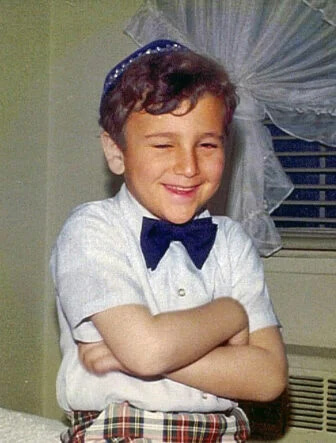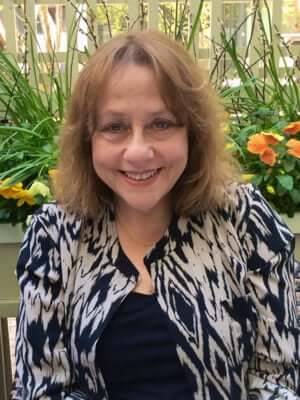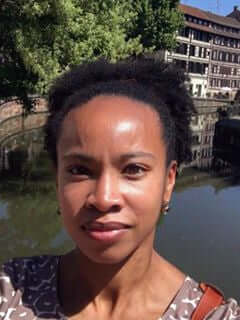The youngest reads the Four Questions. What if the youngest is terrified?
Singing the Four Questions traditionally falls to the youngest child at the Passover Seder. It’s a much loved, and sometimes dreaded, tradition.

Graphic by Angelie Zaslavsky

Jonathan Berman was 3 when he first regaled his extended family with the Four Questions at their Seder, the ritual meal at which Jews each year retell the story of Passover.
Wearing a bow tie and a yarmulke too big for his head, he’d belt them out in fluent Hebrew and English.
“I was a Ma Nishtana star,” Berman said, using the Hebrew name for the Four Questions, which get to the heart of the holiday by asking and answering why Jews celebrate Passover in the first place.
The honor of the Four Questions falls to the youngest person at the table capable of the task, a tradition that reinforces the biblical commandment to pass on the story of the Exodus to the next generation.
But what happens in the not uncommon case where the youngest child recoils at the idea of singing solo in front of what is often a very large, mostly adult gathering?
Now a father in Washington, D.C., Berman recalls when the responsibility of reciting the Ma Nishtana first fell to his son, Boaz, who was 6 at the time — the youngest child.
“He wouldn’t do it,” said Berman, who began to brainstorm alternatives. “Maybe he could mime them. He could be the Marcel Marceau of the Ma Nishtana.”
Determined not to force or bribe, Berman began to think up more realistic ways to make Boaz part of the ritual without traumatizing him.
That’s exactly the right tack to take with a reluctant youngest child, say rabbis and Jewish parents who understand that a terrible experience with a Jewish ritual may resonate well after Passover. The whole idea of the holiday is to retell the defining story of the Jewish people — how the Israelites defy Pharaoh and flee toward freedom — and for each person at the table to understand that struggle for freedom as their own blessing.
But consumed with fear, a youngest child responsible for one of the high points of the Seder isn’t going to connect to the story or create happy Passover memories, said Edythe Mencher, a rabbi ordained in the Reform movement who also works as a therapist specializing in children’s anxiety and depression.

“If a child feels that they are chained to the chair, about to suffer, to be made to build a pyramid they feel unable to build, sent down the Nile, off in a basket on their own — that’s not good,” said Mencher, offering up all the Passover anxiety metaphors she could think of.
It’s up to parents to know that youngest child, and to understand how the Ma Nishtana can be turned into an experience that brings pride and not shame, she said.
‘I got a stomachache’
Amalia Warshenbrot has no fond memories of her childhood Seders.
The former president of the Association of Jewish Libraries, whose home is now Charlotte, North Carolina, was the youngest in her family, an 8-year-old living in the newly formed state of Israel, when she was first called upon to sing the Four Questions. Her grandfather, in a Hebrew dialect different from the one she spoke, sped through the Haggadah, the book that guides Jews through the steps of the Seder and which dates to as early as 170 C.E.
Warshenbrot felt the weight of history upon her, and terrified that she would mangle her part. “I got a stomachache and cried,” she said, remembering how her parents tried to save the situation by singing the Ma Nishtana themselves.
Decades later after immigrating to the U.S., Warshenbrot shielded her own children from such humiliation, never requiring a performance at a Seder if the youngest was unwilling.
But difficult Ma Nishtana moments can also turn into heartwarming ones.
Mencher tells the story of a precocious two-and-a-half-year-old boy who had learned the Ma Nishtana in both Hebrew and English perfectly, and eagerly awaited his debut in the days before Passover. But at the Seder, standing on a chair — the tradition in some households — and with his family’s eyes upon him, he froze.
So the whole table began to sing the Four Questions, and the toddler relaxed and began to bounce, a bounce for every syllable of every question.
“He bounced his way through the entire Ma Nishtana,” said Mencher. “He didn’t give up the attention. And joy was what came across, and the pleasure in how unpredictable kids are. He was pleased to do it in his own way.”
Other families have come up with their own solutions to Ma Nishtana conundrums.
The Four Questions — with feeling

Marcella White Campbell, who lives in the San Francisco Bay Area and consults with Jewish groups on branding and diversity issues, hosted her first Seder when the youngest child at the table was a baby in a highchair, and the next youngest person was Campbell’s sister, who was not a child, and not Jewish at the time.
“She was, however, a drama student, and ready for any opportunity to perform,” Campbell said.
So her sister asked the Four Questions — with feeling. She was the perfect choice not only because she could command an audience, Campbell said, but also because she brought a novice’s curiosity to the reading that enlivened the Seder for both veterans and newcomers.
Beth Berkowitz, a Jewish studies professor at Barnard College, said she — a youngest child herself and self-described shy person — has always appreciated her family’s tradition of having all the youngest siblings from each immediate family at the table recite the Four Questions together.
“Whether they’re 8 years old or 80,” she said.
Adults’ feelings at the Seder table also deserve attention, Mencher said.
Grown-ups, often called upon to recite from other parts of the Haggadah, can dread the spotlight as much as children. They may be self-conscious about a stutter, or their inability to read Hebrew. Weak eyesight can make it hard to see the words on the Haggadah’s pages.
The Torah says that Moses, the prophet of the Exodus, was an uncomfortable speaker, reminded Mencher. “Yet he was our great leader.” Though God didn’t make him an orator, his brother Aaron possessed the gift. “So God said Aaron should talk.”
Take that lesson to your Seder, she suggested, and invite everyone to contribute in a way that makes them feel an important part of it, whether they are young or old, an extrovert or introvert, new to the traditions or not.
Consider allowing a shy youngest child to draw pictures of the Four Questions and hold them up as others sing them, she said. Consider giving the first of the Four Questions to the youngest, and the other three to older children. Or reassure an uncertain Ma Nishtana soloist that holding up a finger will signal a parent to turn the performance into a less-daunting duet.
Berman, who had pictured his son singing Ma Nishtana as he and generations of youngest children before him had sung it in his family, came up with a plan where he divvies up the Four Questions each year among four different people. For the past six years, that’s worked for Boaz, and for his father too.
“The Haggadah is steeped in tradition. It moves me,” said Berman, who also noted that its text has evolved over the past 1,800-or-so years, changing to reflect its times. “I can evolve too.”
This story was originally published in 2017 by RNS.
















